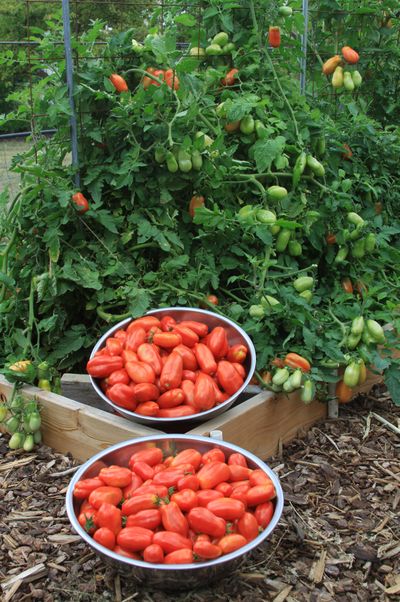Tomatoes dominate a productive gardening season

Now that the gardening season is winding down, it’s time for a performance review of the vegetable crops I grew this year.
Since grafted vegetable plants are all the rage these days, let’s look at those first. I grew three grafted tomatoes (Legend, Brandywine, Chocolate Stripes), two eggplants (Ping Tung, Rosa Bianca) and one bell pepper (California Wonder).
Of the tomatoes, Legend was the most impressive. The plant was robust and absolutely covered with juicy, flavorful tomatoes that ripened well before the end of the season. The other two grafted tomatoes didn’t perform well. Perhaps they needed a longer growing season, but they only produced a few tomatoes each.
The eggplants grew well. I wasn’t sure what to expect, but the plants were taller than conventional ones and each bore three to five large fruits. The pepper plant produced many large bell peppers, more than one would get on a nongrafted plant. We harvested them from midsummer right up to the first frost.
When it comes to growing nongrafted tomatoes, this was truly the year of the tomato in our garden. The Jetstar slicing tomatoes performed really well. The plants were fairly compact but very productive with early-ripening fruits.
I grew San Marzano and Italian Pompeii paste tomatoes and was amazed by how prolific they were. San Marzano is a smaller tomato, but the quantity it produced easily made up for its size. Italian Pompeii produces larger fruits and is a real winner. I’ll definitely grow both again for making flavorful tomato sauce.
As usual, I grew my favorite pole bean (Italian Snap) alongside the newcomer, French Gold. I should know better than to compare any variety next to my tried-and-true Italian beans because everything else pales in comparison. Although pretty and tasty, the golden pole beans were much smaller and less productive.
Our artichoke plants outdid themselves this year in terms of production. Three of the plants had overwintered from last year – a testament to the mildness of the winter – and provided us with plenty of delicious artichokes for dinner. Unfortunately, we discovered that stink bugs love artichokes as much as we do, and they proved to be formidable pests. I’ll have to come up with a game plan for dealing with them next year.
I planted two types of long-day onions (Yellow Spanish, Big Daddy) from starts that came from Dixondale Farms in Texas. They grew beautifully and produced huge bulbs that we’ll be enjoying for months to come.
Celery was a new crop in our garden. I discovered it’s easy to grow and delicious, although growing 10 plants was really too much. I’m hoping to keep it going through the fall by using a floating row cover.
Our three newest raised beds did beautifully for their first season, and I’m certain it was due to the way we layered the soil in them. We put layers of damp newspaper on the ground first, then a thick layer of decomposing leaves topped by compost and soil skimmed from our well-established beds. That mixture apparently did the trick because the crops in them – tomatoes, winter squash, pumpkins and corn – grew incredibly well and provided an amazing harvest.
We found that our new drip irrigation system worked really well for rows of plants, but we might need to do some fine-tuning for growing veggies planted in blocks like lettuce.
This is my final column of the 2013 gardening season. I will update my blog throughout the fall and winter months, so be sure to visit susansinthegarden. blogspot.com. You can also find me on Facebook at facebook.com/ susansinthegarden. And as always, if you have a gardening question, I’m just an email away at inthegarden@live.com.